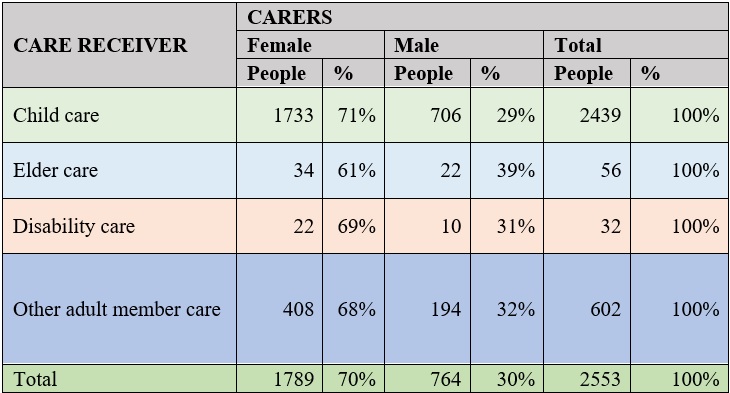The Care Economies in Context project team in Mongolia is working on the estimation of paid and unpaid care sectors and developing some recommendations suitable for further analysis in Mongolia. This report reviews the available data sets collected by the National Statistical Office of Mongolia (NSO), published reports and publicly accessible and administrative data held by the government, and summarizes the latest research aimed at describing how care needs are met in the country.
Unpaid Care Work
As in many other countries, Mongolian Time Use Survey (MTUS) is the primary data source for the unpaid care sector. The first MTUS was conducted in 2000, 2007, 2011, 2015, and 2019. The last TUS was conducted in 2019 and its sampling covered 13,499 individuals from 4,000 households. The survey included household information, personal information, questionnaires on children under five years of age, and diary data of 6,312 persons aged 12 and over in the household. Data collected through household diaries show how many hours per day (asked at 10-minute intervals) an individual spends on activities (coded according to the International Classification of Time Use Statistics).
As of 2019, an adult in the country, spends an average of 15 percent of the total daily time on unpaid work. (NSO, 2020). Mongolian men aged 12 and older spend 27% of their 1,440 minutes a day on paid work, 8% on unpaid work, and the remaining 65% on self-development and activities related to their personal needs. On the other hand, 18% of women’s day is spent on paid work, 20% on unpaid work, and 63% on self-development and personal needs (NSO, 2020). For unpaid care, an adult spends on average 116 minutes on child care, 104 minutes on elder care, 87 minutes on care for disabled people and about 38 minutes for other adult member of their family (See Figure 1).

Source: Researchers’ calculation from Time Use Survey 2019 data, NSO of Mongolia
Women spend 2.5 times more time on childcare than men, 1.5 times more time on elder care, 2.2 times more time on disability care and 2.1 times more time on other adult family members (See Table 1). Urban residents spend more time on unpaid work than rural residents. Urban women spend 1.1 times more time than rural women, and men spend twice as much on unpaid work (NSO, 2020).

Source: Researchers’ calculation from Time Use Survey 2019 data, NSO of Mongolia
The population average growth rate of the country was an average of 1.4% in the last five years. The number of children aged 0-1 has decreased by an average of 0.84% per year, and the number of children of kindergarten age [2-5] has been reduced by 0.35%. As of 2021, there are 148,400 children aged 0-1 and 305,800 children aged 2-5 in Mongolia, which is 13.7% of the population, which means that more than 450 thousand children aged 0-5 need to be cared for in the country every year. Urban women spend more time on childcare compared to urban men, rural men and women, approximately 149 minutes per day on childcare, while urban men spend 134 minutes (See Figure 2)
Childcare is a job that involves people of all ages, takes much time, and takes up the largest share of caregiving work. Looking at the time spent caring for children aged 0-5 years by caregivers’ age group, 12-17-year-olds spend an average of 83 minutes a day, while 18-22-year-old caregivers spend 140 minutes. People aged 23-60 spend 118 minutes a day in childcare. Those over 60 spent 111 minutes on childcare.

Source: Researchers’ calculation from Time Use Survey 2019 data, NSO of Mongolia
In Mongolia, care for elderly is usually carried out by family members, especially by women, wives, daughters, sisters, daughters-in-law. Women spend on average 108 minutes for elder care, while men spend about 98 minutes. Rural women and men spend more time on eldercare than urban dwellers (See Figure 3). The elderly population has increased over the past 20 years. In 2016-2021, Mongolia’s population grew by an average of 1.8 percent per year, while the number of older adults increased by 6.0 percent per year. The population is aging. For instance, in 2010, 7.3% of the total population was elderly; in 2021, it increased to 10.1%.

Source: Researchers’ calculation from Time Use Survey 2019 data, NSO of Mongolia
The NSO routinely collects information about persons with disabilities (PWD) through a household booklet and registry, household surveys, and the census. According to the 2020 Census, a total of 897,400 households were registered in Mongolia, of which 89.5 percent had no persons with disabilities and 94.0 thousand households had one or more members with disabilities. This means that at least one in 10 households in Mongolia have a persons with a disabilities (NSO, 2022).
Like other unpaid work, 99.9% of the work of caring for a disabled person is conducted by family members. The NSO report on MTUS 2019 estimates hours spent caring for an elderly, sick, or disabled adult but does not explicitly estimate how many hours are actually spent caring for a person with a disability (NSO, 2020). Therefore, in this research, we selected households with disabled citizens and made calculations. By our calculations, a person spends 87 minutes on average in care for a disabled family member, and women spend twice as much time as men.

Source: Researchers’ calculation from Time Use Survey 2019 data, NSO of Mongolia
Rural women spend more time caring for people with disabilities. In particular, women living in rural areas spend more than half an hour more time caring for a disabled person in the household than urban women, while urban men spend more time caring for a disabled person than rural men (See Figure 4).
Conclusion
A care economy includes caretakers and caregivers those who provide care, both paid and unpaid. Our research, we hope, will help policymakers in the country solve problems related to the economic growth, economic production as well as non-GDP production in the economy. Care, both paid and unpaid, is the most important engine for the economic growth, and well-being of people and country.
Project Lead
-

Otgontugs Banzragch
Researcher

